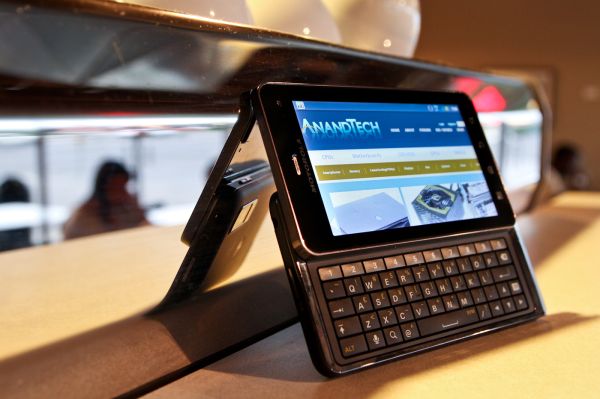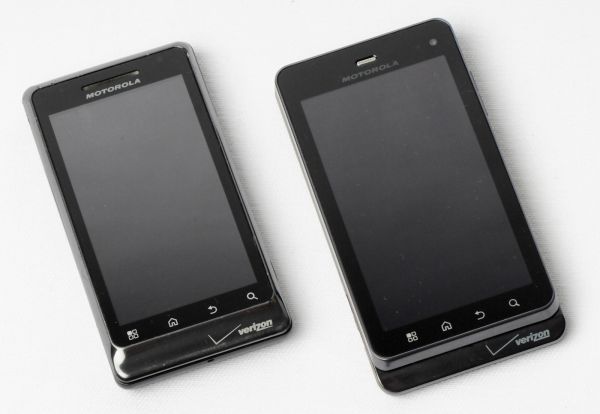Motorola Droid 3 Review - Third Time's a Charm
by Brian Klug on July 30, 2011 12:01 AM ESTIf ever a product has summed up the progression of the Android ecosystem, it’s the Motorola Droid. The first Droid catapulted Android into the mainstream with its first 2.x release, and since then the Droid itself has seen a yearly update cadence that honestly has shown no sign of stopping. The updates thus far track the trends that we’ve seen affect the Android ecosystem as a whole - newer and better versions of Android alongside ever increasing SoC performance, display improvements, camera improvements, and refined hardware design.
I think that pretty much sums up what kind of update the Motorola Droid 3 (henceforth just Droid 3) is. It’s an iterative product launch, for sure, but that belies just how good the improvements all around really are. I noted a few of them already - the Droid 3 includes a dual core OMAP 4430 SoC, larger 4” qHD display, more internal storage, better camera, front facing camera, and most notably a much improved 5 row QWERTY keyboard.
Of course the huge question mark is what has improved connectivity-wise on the Droid 3. There’s no 4G LTE baseband, however, instead of repeating the Droid 2 and Droid 2 Global duopoly, Motorola just went ahead and made the Droid 3 global from the start. That’s right, it’s a dual-mode phone. It’s no consolation if you’re still waiting for an LTE enabled device with a physical keyboard (for that, you’ll have to wait for Samsung to release its rumored next device), but in my mind right now you can either have multi-mode global (CDMA2000 and GSM/UMTS) compatibility or multi-mode (CDMA2000 and LTE) with 4G connectivity. As of yet there’s no having it both ways.
We’ll talk more about all of that in due time, but for now let’s just go over the Droid 3’s outward physical appearance and hardware.
First off, the Droid 3 is notably larger than its predecessor. It’s 3 mm wider, 7 mm taller, but almost 1 mm thinner. Those changes in outline are both to accommodate the 4” screen (as opposed to 3.7”) and likewise the additional keyboard row. Mass is up as well, from 169 to 184 grams. I won’t bore you with all the specifications that have changed, you can just check out the table below.
| Physical Comparison | ||||||
| HTC Thunderbolt | Motorola Droid 2 | Motorola Droid X2 | Motorola Droid 3 | |||
| Height | 122 mm (4.8") | 116.3 mm (4.6") | 126.5 mm (4.98") | 123.3 mm (4.85") | ||
| Width | 67 mm (2.63") | 60.5 mm (2.4") | 65.5 mm (2.58") | 64.1 mm (2.52") | ||
| Depth | 13.2 mm (0.52") | 13.7 mm (0.54") | 9.9 - 14.4 mm (0.39"-0.57") | 12.9 mm (0.51") | ||
| Weight | 183.3 g (6.46 oz) | 169 g (5.9 oz) | 148.8 g (5.25 oz) | 184 g (6.49 oz) | ||
| CPU | 1 GHz MSM8655 45nm Snapdragon | 1 GHz Cortex-A8 OMAP 3620 | 1 GHz Dual Core Cortex-A9 Tegra 2 AP20H | 1 GHz Dual Core Cortex-A9 OMAP 4430 | ||
| GPU | Adreno 205 | PowerVR SGX 530 | ULP GeForce | PowerVR SGX 540 | ||
| RAM | 768 MB LPDDR2 | 512 MB LPDDR2 | 512 MB LPDDR2 | 512 MB LPDDR2 | ||
| NAND | 4 GB NAND with 32 GB microSD Class 4 preinstalled | 8 GB integrated, preinstalled 8 GB microSD | 8 GB NAND, 8 GB microSD class 4 preinstalled | 16 GB NAND, up to 32 GB microSD | ||
| Camera | 8 MP with autofocus and dual LED flash, 720p30 video recording, 1.3 MP front facing | 5 MP with dual LED flash and autofocus | 8 MP with AF/LED Flash, 720p30 video recording | 8 MP with AF/LED Flash, 1080p30 video recording, VGA (0.3MP) front facing | ||
| Screen | 4.3” 800 x 480 LCD-TFT | 3.7" FWVGA 854 x 480 IPS-LCD | 4.3" 960 x 540 RGBW LCD | 4.0" 960 x 540 RGBW LCD | ||
| Battery | Removable 5.18 Whr | Removable 5.2 Whr | Removable 5.65 Whr | Removable 5.65 Whr | ||
Subjectively however, I was shocked at just how thin the Droid 3 feels in the hand in spite of the slide-out keyboard. It seems like generally there’s a certain amount of unacceptable overhead that always comes alongside including an actual keyboard, yet the Droid 3 manages to do it without making it painfully obvious that everything was designed around it instead of with it.
The other major difference is how much different the Droid 3 feels compared to the Droid 2 - entirely as a result of the device using squared edges instead of the rounded chamfers that ringed the Droid 2. There’s been a recent slow march away from rounded industrial design to one dominated by rigid 90 degree angles, and the Droid 3 follows that trend with this move.












84 Comments
View All Comments
7amood - Saturday, July 30, 2011 - link
that's nice to hearplease don't forget to talk about the screen problem
http://www.gsmarena.com/samsung_galaxy_s_ii_displa...
It's really hard to accept that my perfect SUPER AMOLED is not perfect.
It's harder to accept the fact that samsung don't give a f*** about me since they already have my money.
takumsawsherman - Saturday, July 30, 2011 - link
On the GL benchmark, it shows iPhone 3GS running faster than iPhone 4. Is this correct? If so, why do you think iPhone 4 is performing worse on the test?Ryan Smith - Sunday, July 31, 2011 - link
GLBench runs at the device's native resolution. The iPhone 4 is 4x the resolution of the 3GS.Lucian Armasu - Sunday, July 31, 2011 - link
It looks like OMAP is on the way out from the market, though:http://semiaccurate.com/2011/07/29/texas-instrumen...
Now the fight will be left between Nvidia, Qualcomm and Samsung.
martyrant - Sunday, July 31, 2011 - link
My VP wanted one, so we both got one the same day. I don't talk on the phone as much, but after a week I did a conference call on it and it drained it from 80% to 15% in under an hour. I also just left it on a charger last night, saw it go from 30-90%, went to bed, got up and just checked it (while still plugged into the charger) and it's back at 30%. Did you see any strange anomalies when running your battery life tests? My VP loves the phone, but hates the battery--his dies all the time and so does mine. It seems like while your tests look awesome, the real life performance of this phone is nowhere near in line with those tests when it comes to battery. I have tried max battery saver, just about everything---had to get the VP an extended battery pack and he still doesn't know if he can continue to use this phone because of the battery issues.martyrant - Sunday, July 31, 2011 - link
It went to 20% from 30% while writing that comment, while plugged into the charger. Hot, right?josby - Sunday, July 31, 2011 - link
Same here. I bought mine the day they were released in stores, but I've been anxiously awaiting the AnandTech review of it because I knew it would include battery life comparisons. I came from a T-Mobile G2 (running Cyanogen7) and have all the same apps, with the same update intervals set, on my Droid3 as I had on the G2, yet the battery life is very noticeably worse. It can barely make it from morning til night even with very light usage.In fact, I always left my G2's wifi on, yet the Droid3 still doesn't last as long even if I leave wifi off.
Yet, the G2 does considerably worse than the Droid3 in the battery life tests in this review.
Brian Klug - Sunday, July 31, 2011 - link
That's odd - I wonder what kind of signal environment he was in when he made that call. Could you find out what Rx signal strength was in dBm?The only part of the entire cellular architecture that has a power control loop is the phone->base station, and when you're in a low signal environment the phone can increase Tx power to be "heard" by the base station and thus hurt battery life considerably. We always test in areas with at least -75 dBm or better.
-Brian
photoguru - Monday, August 1, 2011 - link
I had major problems with my battery life until I realised that the power adapter for the Droid 3 requires 5.1v at 850mA which is quite a bit higher than most chargers. Mine actually died while browsing the web and being plugged into a Belkin usb charger.Also, theres an issue with programs not turning off once you exit them. Task killers should fix it but I actually just went through the programs and manually adjusted which ones can continue to run in the background. Now my battery lasts almost twice as long as it did before, and quite a bit longer than my droid 1 and droid 2 global.
anandtech pirate - Sunday, July 31, 2011 - link
how about the Evo3D?